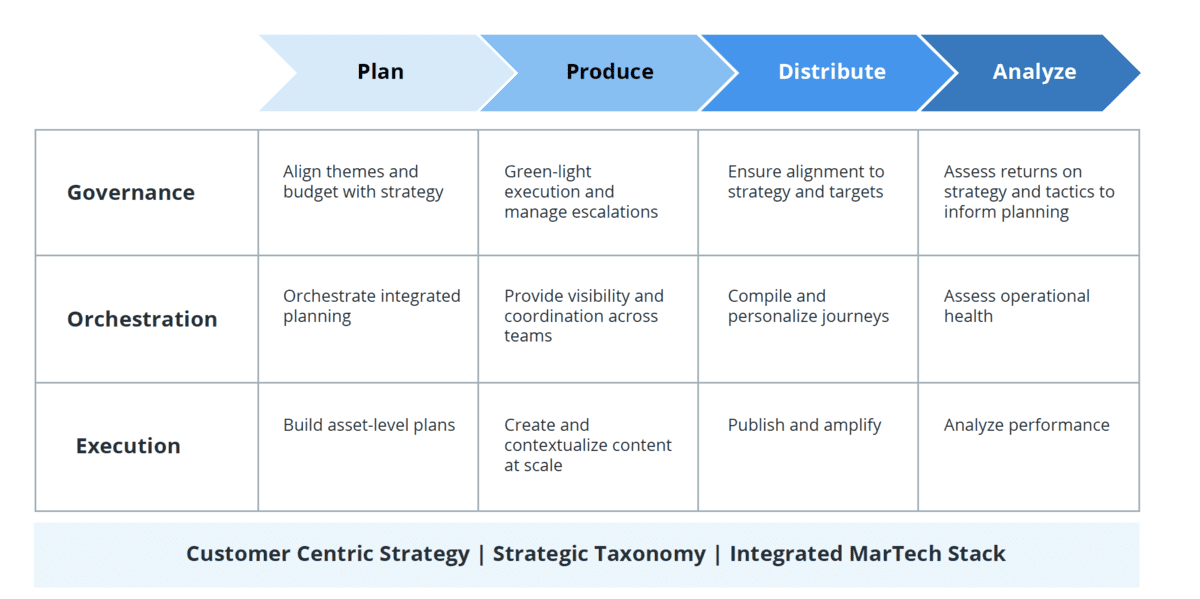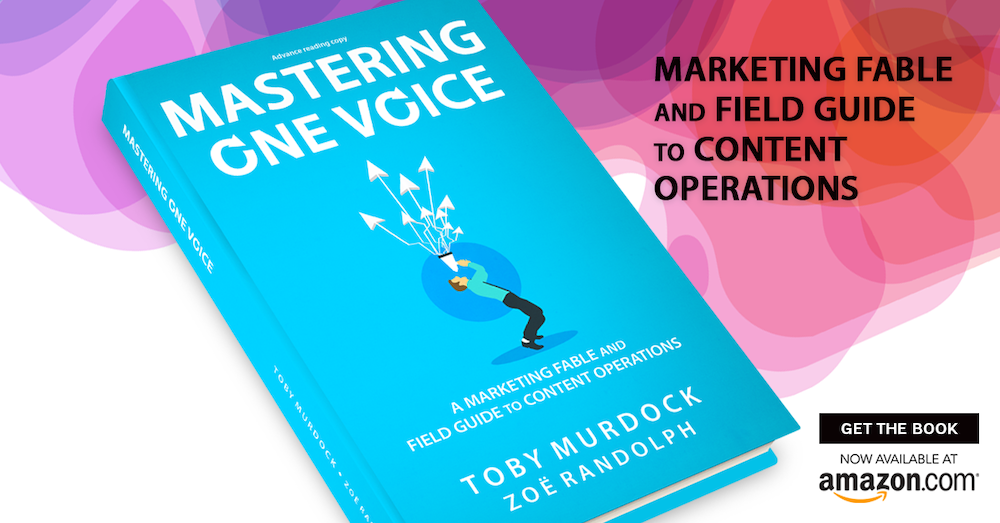Like any fad, the early days of modern B2B content marketing seemed too good to be true.
And in many ways, they were. Winning customers with a great blog or a viral video? Sign me up! Companies rushed to hire “brand journalists” and build internal content teams built like newsrooms whose jobs were to pump out content that earned eyeballs, clicks, and pageviews. We purchased MarTech (and then some more MarTech) to help us create more content and get it in front of more people.
More. Faster. But to what end?
The premise of these initiatives wasn’t wrong: It was a reaction to a very real shift in the relationship between companies and customers. With buyers controlling much of their own decision-making journeys and expecting consultative sellers more than ever, all of us on the other side of the equation must be responsible for earning and keeping trust through great customer experiences built on content, not just great products or salespeople.
But in the rush to win the content marketing game, we started maximizing new digital marketing tools and channels, feeding them endless volumes of content in order to drive engagement through them.
It became chaos.
And that chaos created a new challenge: How could we coordinate all the different functions that create and share content so that they can come together to build a consistent message that resonates with customers and makes it easier for them to buy from us?
In response to this daunting question, a new discipline has arisen: content operations.
Content operations (n.): An internal operating model that moves teams from status to strategy, bringing visibility, collaboration, and confidence to content at scale.
The key word in that definition is internal. It’s about getting your house in order inside your organization so that you’re able to speak in one, coherent voice to the market.
Content ops is a topic we at Upland Kapost have been talking about for a while now (check our white paper and full-length book on the subject for a deep dive), so we thought we’d tackle the three biggest questions we hear about what implementing a content operation looks like IRL:
1. What Does a Content Operation Change?
Much like Agile and similar systems, a content operation is designed to address several fundamental flaws in the status quo. The details of each individual content operation differ, but any team building a content operation should work to transform their approach in these key ways:
Reactive → Proactive
Instead of constantly producing content in response to requests from across the organization, teams produce content proactively in alignment to a common strategy.
Confusion → Visibility
Instead of wondering what others are working on, contributors at every level have visibility into the planned, in-progress, and completed projects of their peers.
New → Reuse
Instead of always looking to produce new content, teams check first whether they might be able to reuse and repurpose existing content to fit their particular needs.
Ad hoc → Planned
Instead of unplanned, random acts of content, teams build—and primarily stick to—structured, strategic plans.
More → Less
Instead of working to maximize content output, teams produce less. The content they do produce is the most strategic, useful, and aligned.
Together, the result of these shifts is a more thoughtful team of people able to focus their energy on the projects that will most impact the business. With less time and energy spent on coordination, uncertainty and unaligned, unnecessary work, members of a content operation simultaneously grow their impact while reducing their workload.
2. Who’s Part of a Content Operation?
Marketing sits at the helm of the content operation, but the initiative is dead in the water without the active participation and buy-in of all revenue teams, by which we mean:
- All functions of marketing, including corporate communications, content marketing, demand generation, product marketing, and more, who craft the message through content.
- Sales teams, who deliver the unified message in person.
- Post-sales teams including services, implementation, success, support, and any others who assume responsibility for the customer experience once prospects become customers.
- All business units, divisions, and product lines, which, though distinct, work together to tell a cohesive brand story.
- All regions, which adapt a central message for their local audiences.
It’s a long list, to be sure. But these groups don’t have to join you in content operations bliss all at once. In fact, they shouldn’t.
During the early stages, be intentional about who you bring on as pilot members of your content operation. You’ll be well-served by starting with the most enthusiastic allies. These forward-thinking folks will allow you to stress-test your vision with a smaller sample size and work out the kinks before bringing a refined approach to the larger group.
As success grows, it becomes easier and easier to integrate new groups, especially as members of pilot programs evangelize the concept across the larger organization.
3. How Does a Content Operation Work?
We like to visualize a content operation both across the content lifecycle (from planning through to analysis) and across three layers of granularity (from execution up to governance). It looks a little something like this:

It’s a little complicated, so don’t worry about taking it all in at once. Let’s go through the chart bit by bit.
The Foundation
Customer-Centric Strategy
Everything optimized on an operational level must be done in the service of customer-centricity. It should be the guiding light that leads stakeholders at every level to make choices about where to allocate resources, which projects to prioritize, and how to measure success.
Strategic Taxonomy
A strategic taxonomy tracks the attributes most significant to the content an organization produces. For many, this will include tags like persona and buying stage, but it can also be adapted based on your specific needs. A robust, shared taxonomy is what allows teams to find and visualize their coverage and understand what’s working across, for example, specific product lines or messaging themes.
A taxonomy is more than a filing system: It’s an agreement between stakeholders about what characteristics are most important to consider when planning and producing content.
Integrated MarTech
Like any other modern undertaking, a content operation must be built across an integrated tech stack. The best stacks are built around what’s usually called a content marketing platform (CMP)—I like to think of them as content operations platforms (COPs), too, but you may not hear that much in the market—which serves as a single source of truth for all content activity, from planning to analysis. In addition, it integrates with marketing automation, reference management, sales enablement, and other tools.
Without good MarTech, it will be nearly impossible to turn your content operations vision into a reality.
The Strategic Levels
The phases of the lifecycle will be familiar to you, but let’s take a moment to consider content the three altitudes, which go from high-level governance down to tactical execution. The goals of each level are distinct, but each go hand-in-hand:
Governance
…is the highest strategic level of a content operation. Those responsible for this level must allocate resources and ensure accountability to maximize the impact of content.
Orchestration
…requires coordinating activities across teams, regions, product lines, and more to ensure a cohesive experience across the various touchpoints a prospect and/or customer might have with your organization. Though individual teams will still do much of their work separately, proper orchestration ensures they’re all working toward shared objectives and aligning around core themes.
Execution
…brings higher-level strategy to life in every asset by enabling marketers to work effectively and efficiently and adapt to ever-changing demands. Creators should know why they’re doing the work they are, and how it levels up to broader strategic goals. This understanding also gives creators more autonomy to say yes or no to projects, allowing them to focus only on the work with real strategic impact.
Takeaways
Customers buy our full story, not bits and pieces of it; views, likes, and downloads aren’t ends in and of themselves. It’s why we need to align our entire revenue team around a core message and a clear-sighted way of working. Like individual musicians each playing their own tune during an orchestra warm-up, our customer experience can arrive discordant and unpleasant, no matter the beauty of each individual contribution.
Rather than maximizing the volume of each instrument, marketing leaders must prioritize coordinating the orchestra to play the full piece together in harmony.
If you’re ready to build your content operation, we’ve got the book for you:

